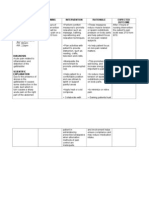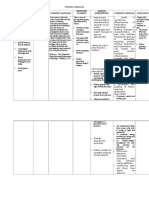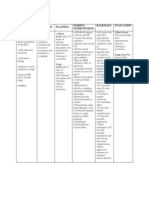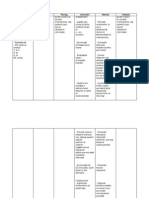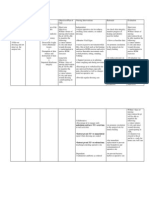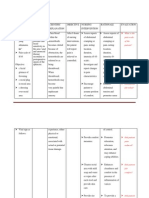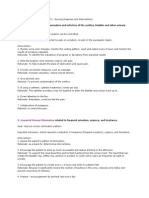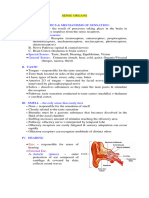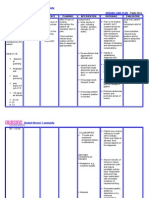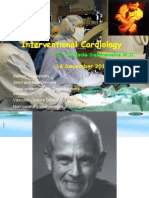5NCP
5NCP
Uploaded by
Sara ThorntonCopyright:
Available Formats
5NCP
5NCP
Uploaded by
Sara ThorntonOriginal Title
Copyright
Available Formats
Share this document
Did you find this document useful?
Is this content inappropriate?
Copyright:
Available Formats
5NCP
5NCP
Uploaded by
Sara ThorntonCopyright:
Available Formats
ASSESSMENT DIAGNOSIS PLANNING INTERVENTION RATIONALE EVALUATION
Subjective:
Sobrang sakit nitong
tahi ko. as verbalized
by the patient.
Objective:
>Pain scale of 8/10
>Teary eyed
>(+) guarding
behavior
>(+) facial grimace
>Irritable
>Pale palpebral
conjunctiva
>Skin warm to touch
V/S taken as follows:
T=
PR=
RR=
BP
Acute pain related to
disruption of skin and
tissue secondary to
cesarean section.
After 4hrs. of nursing
intervention, patient
will verbalize
decrease intensity of
pain from 8/10 to
3/10.
Independent:
>Established rapport.
>Monitored vital
signs.
>Assessed quality,
characteristics,
severity of pain.
>Provided
comfortable
environment-
changed bed linens
and turned on the
electric fan.
>Instructed to put
pillow on the
abdomen when
coughing or moving.
>Instructed patient to
do deep breathing
and coughing
>To have a good
nurse-client
relationship.
>To establish a
baseline data.
> To establish a
baseline data for
comparison in making
evaluation and to
assess for possible
internal bleeding.
>Calm environment
helps to decrease the
anxiety of the patient
and promote
likelihood of
decreasing pain.
>To check for
diastasis recti and
protect the area of
the incision to
improve comfort. And
to initiate
nonstressful muscle-
setting techniques
and progress as
tolerated, based on
the degree of
separation.
>For pulmonary
ventilation, specially
when exercising, and
After 4hrs. of nursing
intervention, the
patient verbalized
pain decreased from
a scale of 8/10 to
3/10 as evidenced by
(-) facial grimace
(-) guarding behavior.
Frequent small talks
with significant
others.
GOAL MET.
exercise.
>Provided
diversionary
activities. Initiate
ankle pumping, active
lower extremity ROM
and walking.
Collaborative:
>Administer analgesic
as per doctors order.
to relieve stress and
promote relaxation.
>To promote
circulation, prevent
venous stasis,
prevent pressure on
the operative site.
>Relieves pain felt by
the patient.
Subjective:
>none
Objective:
>dressing dry and
intact
V/S taken as follows:
T=
PR=
RR=
BP=
Risk for infection
related to inadequate
primary defenses
secondary to surgical
incision.
STG:
After 4hrs. of nursing
intervention, patient
will be able to
understand causative
factors, identify signs
of infection and
report them to health
care provider
accordingly.
LTG:
After 2-3 days of
nursing intervention,
patient will achieve
timely wound
healing, be free of
purulent drainage or
erythema, be afebrile
and be free of
infection.
Independent:
>Monitor vital signs.
>Inspect dressing and
perform wound care.
>Monitor WBC.
>Monitor
temperature,
redness, swelling,
increased pain, or
purulent drainage at
incisions.
>Wash hands and
teach other
caregivers to wash
hands before contact
with patient between
>To establish a
baseline data.
>Moist from drainage
can be a source of
infection.
>Rising WBC indicates
bodys efforts to
combat pathogens;
normal values: 4000-
11,000 mm
3
>These are signs of
infection.
>Friction and running
water effectively
remove
microorganisms from
hands. Washing
Patient is expected to
be free of infection,
as evidenced by
normal vital signs and
absence of purulent
drainage from
wounds, incisions,
and tubes.
procedures with
patient.
>Encourage fluid
intake of 2000ml to
3000ml per day.
>Encourage coughing
and deep breathing:
consider use of
incentive spirometer.
Collaborative:
>Administer
antibiotics as per
doctors order.
between procedures
reduces the risk of
transmitting
pathogens from one
area of the body to
another.
>Fluids promote
diluted urine and
frequent emptying of
bladder; reducing
stasis of urine, in
turn, reduces risk of
bladder infection or
UTI.
>These measures
reduce stasis of
secretions in the
lungs and bronchial
tree. When stasis
occurs, pathogens
can cause upper
respiratory infections,
including pneumonia.
>Antibiotics have
bactericidal effect
that combats
pathogens.
Objective Cues:
>Patient has not yet
eliminated since
delivery.
>Absence of bruit
sounds.
Risk for constipation
related to post
pregnancy secondary
to cesarean section.
STG:
Within 4hrs. of
nursing intervention,
the patient will be
able to demonstrate
behaviors or lifestyle
Independent:
>Ascertain normal
bowel functioning of
the patient, about
how many times a
day she defecate.
>This is to determine
the normal bowel
pattern.
After 4hrs. of nursing
interventions, the
patient was able to
identify measures to
prevent infection as
manifested by clients
>Normal pattern of
bowel has not yet
returned
changes to prevent
developing problem.
LTG:
Within 3 days of
nursing interventions,
the patient will be
able to maintain
usual pattern of
bowel functioning.
>Encourage intake of
foods rich in fiber
such as fruits.
>Promote adequate
fluid intake. Suggest
drinking of warm
fluids, especially in
the morning to
stimulate peristalsis.
>Encourage
stimulation such as
walking within
individual limits.
>However, since she
has had cesarean,
also encourage
adequate rest
periods.
Collaborative:
>Administer bulk-
forming agents or
stool softeners such
as laxatives as
indicated or
prescribed by the
physician.
>To increase the bulk
of the stool and
facilitate the passage
through the colon.
>To promote moist
soft stool.
>To stimulate
contractions of the
intestines and
prevent post
operative
complications.
>To avoid stress on
the cesarean
incision/wound.
>To promote
defecation.
verbalization of:
Iinom ako ng
maraming tubig at
kakain ng prutas para
makadumi ako.
You might also like
- Clinical Ophthalmology Jatoi PDF DownloadDocument4 pagesClinical Ophthalmology Jatoi PDF DownloadUmnah Saif21% (14)
- Nursing Care Plan For CellulitisDocument6 pagesNursing Care Plan For CellulitisVilma Delos Reyes63% (16)
- NCP CholeDocument8 pagesNCP CholeAndrewAlvinTemploNo ratings yet
- Nursing Care PlanDocument37 pagesNursing Care Planpia lestrange100% (6)
- Tooth TraumaDocument111 pagesTooth TraumaNavroop Kaur50% (2)
- NCP CholehgxkDocument9 pagesNCP CholehgxkPrincess Gutierrez RositaNo ratings yet
- NCP For Ectopic PregnancyDocument4 pagesNCP For Ectopic PregnancyClarissa_Dante_735850% (4)
- NCP PcapDocument2 pagesNCP PcapGacutan Jonathan89% (27)
- NCP TesticularDocument8 pagesNCP TesticularPrincess Gutierrez Rosita67% (3)
- Goljan - CardiovascularDocument22 pagesGoljan - Cardiovascularcollege3No ratings yet
- Chapter 1 - Psychology As A ScienceDocument21 pagesChapter 1 - Psychology As A Sciencevarunas_267% (3)
- Ventricular Septal Defect, A Simple Guide To The Condition, Treatment And Related ConditionsFrom EverandVentricular Septal Defect, A Simple Guide To The Condition, Treatment And Related ConditionsNo ratings yet
- The Ride of Your Life: What I Learned about God, Love, and Adventure by Teaching My Son to Ride a BikeFrom EverandThe Ride of Your Life: What I Learned about God, Love, and Adventure by Teaching My Son to Ride a BikeRating: 4.5 out of 5 stars4.5/5 (2)
- COMPREHENSIVE NURSING ACHIEVEMENT TEST (RN): Passbooks Study GuideFrom EverandCOMPREHENSIVE NURSING ACHIEVEMENT TEST (RN): Passbooks Study GuideNo ratings yet
- Postoperative Nursing Care Plan For Cesarian Section Patient Case Pres orDocument6 pagesPostoperative Nursing Care Plan For Cesarian Section Patient Case Pres orLoren EstefanNo ratings yet
- NCP CSDocument9 pagesNCP CSFreida Marie PiczonNo ratings yet
- Fracture NCPDocument3 pagesFracture NCPCandy Paraiso AgustinNo ratings yet
- NCP Proper TahbsoDocument3 pagesNCP Proper TahbsoMiriam EstradaNo ratings yet
- Nursing Care Plan Assessment Planning Intervention Rationale Expected OutcomeDocument4 pagesNursing Care Plan Assessment Planning Intervention Rationale Expected OutcomeAshley Kate SantosNo ratings yet
- Planning (Nursing Care Plans)Document10 pagesPlanning (Nursing Care Plans)Kier Jucar de GuzmanNo ratings yet
- Nursing Care Process: Subjective CuesDocument12 pagesNursing Care Process: Subjective CuesJazzmin Angel ComalingNo ratings yet
- Nursing Care PlansDocument14 pagesNursing Care PlansTels Dela PeñaNo ratings yet
- NCP SicuDocument6 pagesNCP SicuChoco MuchoNo ratings yet
- Kedarsing Care PlanDocument9 pagesKedarsing Care PlanAmit BarveNo ratings yet
- Nursing Care Plan FinalDocument16 pagesNursing Care Plan FinalErickson OcialNo ratings yet
- DengueDocument14 pagesDengueKarenn Joy Concepcion OctubreNo ratings yet
- NCP SurgeryDocument10 pagesNCP SurgeryChristina Espiña EjercitoNo ratings yet
- Nursing Care PlanDocument4 pagesNursing Care PlanJessa BorreNo ratings yet
- Nursin Care Plan For GastroenteritisDocument7 pagesNursin Care Plan For GastroenteritisSheana Tmpl100% (2)
- NCPDocument8 pagesNCPzharienabNo ratings yet
- 4 NCP's FinalDocument9 pages4 NCP's FinalZenel Yap100% (1)
- NCP Fo Excess FluidDocument4 pagesNCP Fo Excess FluidKaye MalitNo ratings yet
- Chicken Pox NCPDocument3 pagesChicken Pox NCPAiza Oronce50% (2)
- NCP AppendicitisDocument8 pagesNCP AppendicitisAaron_Kim_Vela_4636No ratings yet
- Assessment Diagnosis Objectives Nursing Interventions Rationale Evaluation S STO After 45 DX: STO Goal FullyDocument5 pagesAssessment Diagnosis Objectives Nursing Interventions Rationale Evaluation S STO After 45 DX: STO Goal FullyMar OrdanzaNo ratings yet
- NCPDocument3 pagesNCPGian Arlo Hilario Castro100% (6)
- NCP AllDocument7 pagesNCP AllJapoy Arancillo ParconNo ratings yet
- "May Mga Sugat Ako.": As Verbalized by The PatientDocument6 pages"May Mga Sugat Ako.": As Verbalized by The Patientedifier_moonNo ratings yet
- NCP NminDocument5 pagesNCP NminkrizziajNo ratings yet
- Nursing Care PlansDocument6 pagesNursing Care PlansjessamariesabioNo ratings yet
- Uti NCPDocument4 pagesUti NCPaagujar100% (4)
- Cue Problem Scientific Explanation Planning Interventions Rationale EvaluationDocument5 pagesCue Problem Scientific Explanation Planning Interventions Rationale EvaluationJanyn Abella ReyesNo ratings yet
- NCP AppendectomyDocument6 pagesNCP AppendectomyDaryl Valerio Francisco100% (1)
- CJ C J CJ CJ Cî CJ CJ C C ! "! Cî C Ë # C Ë # CJ$ C C 0 "% C C & C C C Ë Î C "' (C Ëj "ËjDocument105 pagesCJ C J CJ CJ Cî CJ CJ C C ! "! Cî C Ë # C Ë # CJ$ C C 0 "% C C & C C C Ë Î C "' (C Ëj "ËjShirin Forbes Aquino100% (2)
- NCP For EclampsiaDocument6 pagesNCP For EclampsiaXtine Soliman Zamora100% (3)
- NCP HemorrhoidsDocument10 pagesNCP HemorrhoidsFate Zephyr100% (2)
- NCP CvaDocument7 pagesNCP CvaEmerson SilverioNo ratings yet
- Diarrhea NCPsDocument10 pagesDiarrhea NCPsJoia De LeonNo ratings yet
- NCP (Age)Document5 pagesNCP (Age)justinmhayNo ratings yet
- NCPDocument8 pagesNCPFaustino LicudNo ratings yet
- AppendectomyDocument4 pagesAppendectomyKyre LandinginNo ratings yet
- BHTDocument18 pagesBHTNitesh KumawatNo ratings yet
- Nursing Care Plan PediaDocument7 pagesNursing Care Plan PediaYvonne Niña Aranton100% (1)
- NCP Urinary Tract InfectionDocument4 pagesNCP Urinary Tract InfectiondollythesheepNo ratings yet
- NCP PPHDocument2 pagesNCP PPHmikee-berredo-9975No ratings yet
- GastroenteritisDocument8 pagesGastroenteritistanlimdania100% (3)
- NCPDocument10 pagesNCPMack Jhed AnarconNo ratings yet
- NCP HicbanDocument4 pagesNCP HicbanJenn chanNo ratings yet
- NCP RevisedDocument7 pagesNCP RevisedJessa BorreNo ratings yet
- Actual ManagementDocument7 pagesActual ManagementApOlle Defiesta - DOminguezNo ratings yet
- NCP Pain - ArthroDocument6 pagesNCP Pain - ArthroKDnurseboyNo ratings yet
- TÉCNICAS DEL AUXILIAR DE ENFERMERÍA EN EL ÁREA DE QUIRÓFANOFrom EverandTÉCNICAS DEL AUXILIAR DE ENFERMERÍA EN EL ÁREA DE QUIRÓFANONo ratings yet
- Risk Factors For Falls in Hospital In-Patients: A Prospective Nested Case Control StudyDocument7 pagesRisk Factors For Falls in Hospital In-Patients: A Prospective Nested Case Control StudyNurhasanah HaryaniNo ratings yet
- Clear Trac FlexibleDocument2 pagesClear Trac Flexibleapi-19808945No ratings yet
- Medsurg Neuro Sense OrgansDocument25 pagesMedsurg Neuro Sense Organsj UNo ratings yet
- Tick and Tickborne DiseaseDocument321 pagesTick and Tickborne Diseaseoscar_varNo ratings yet
- Dukha (Pain) As Interpreted in Medical Terminology With Special Reference ToDocument5 pagesDukha (Pain) As Interpreted in Medical Terminology With Special Reference Toprashantjha192124No ratings yet
- CLMC 1 Lecture: Cerebro Spinal FluidDocument105 pagesCLMC 1 Lecture: Cerebro Spinal FluidJoseph SabidoNo ratings yet
- 2016 - BTS-ICS Guidelines For The Ventilatory Management of Acute Hypercapnic Respiratory Failure in AdultsDocument44 pages2016 - BTS-ICS Guidelines For The Ventilatory Management of Acute Hypercapnic Respiratory Failure in AdultsRizky AndrianiNo ratings yet
- Drs List CenterDocument10 pagesDrs List CenterAdil ShahzadNo ratings yet
- Scrub Forms NewDocument6 pagesScrub Forms Newbluenurse88No ratings yet
- Mental Status ExamDocument13 pagesMental Status ExamTina_No ratings yet
- Quiz PDFDocument3 pagesQuiz PDFAb Staholic BoiiNo ratings yet
- Special Report: Chicken Soup Inhibits Neutrophil Chemotaxis in VitroDocument8 pagesSpecial Report: Chicken Soup Inhibits Neutrophil Chemotaxis in VitroaallieviNo ratings yet
- Hand Soap Evaluation LabDocument4 pagesHand Soap Evaluation LabCg Ida Home TuitionNo ratings yet
- Graves DiseaseDocument7 pagesGraves DiseaseNader SmadiNo ratings yet
- Letter To W. Stephen Muldrow USAFLM Re Natasha Aguilar - Cesar Gamero - May-14-2017Document46 pagesLetter To W. Stephen Muldrow USAFLM Re Natasha Aguilar - Cesar Gamero - May-14-2017Neil GillespieNo ratings yet
- Collocations For IELTS - Collin PDFDocument42 pagesCollocations For IELTS - Collin PDFXuantri NgoNo ratings yet
- EpilepsyDocument38 pagesEpilepsyJareena BegumNo ratings yet
- Nursing Care Plan Peptic UlcerDocument3 pagesNursing Care Plan Peptic UlcerAntonio G. Cordillon100% (2)
- Diagnosa Dan Tatalaksana Pada Hemoroid Derajat IV: Laporan KasusDocument4 pagesDiagnosa Dan Tatalaksana Pada Hemoroid Derajat IV: Laporan KasusFajri AkhmadNo ratings yet
- Ophthalmology Product CenterDocument11 pagesOphthalmology Product CenterJihad Elias Chahla0% (1)
- Pain JuniDocument36 pagesPain JuniNi Putu Ari FebriantariNo ratings yet
- Discontinued Sources From Scopus September 2020Document42 pagesDiscontinued Sources From Scopus September 2020Dr. Gaurav SinhaNo ratings yet
- All Ceramic System Used in DentistryDocument24 pagesAll Ceramic System Used in DentistryHussam Jarayseh0% (1)
- An Assignment On Surgery subject:-SHOCK (Definition, Classification and Pathophysiology of Shock)Document8 pagesAn Assignment On Surgery subject:-SHOCK (Definition, Classification and Pathophysiology of Shock)manish soniNo ratings yet
- Interventional CardiologyDocument217 pagesInterventional Cardiologymicheal1960100% (1)
- HTM0101PartC STERILIZER PDFDocument99 pagesHTM0101PartC STERILIZER PDFLuis CárdenasNo ratings yet


















